ASUS N53JF: Midrange 15.6” 1080p, Take Four
by Jarred Walton on December 28, 2010 1:40 AM ESTGaming Performance
We’ve covered this ground several times of late: 1080p with “midrange” mobile graphics really isn’t great for playing games, but at least you can turn down the resolution to get reasonable performance. We’ve run our Low, Medium, and High benchmarks at both the standardized resolutions as well as 1080p, but you’ll generally want to stick to medium quality or lower if you want to run at native resolution.

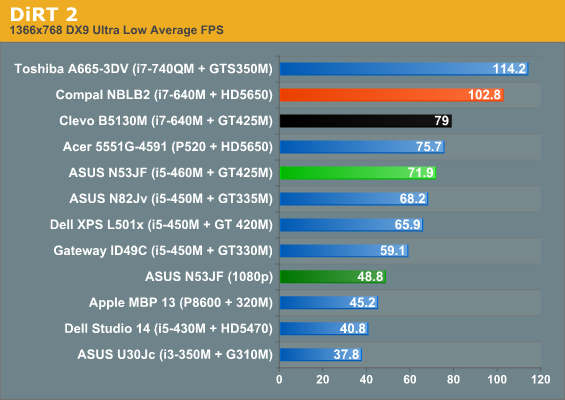
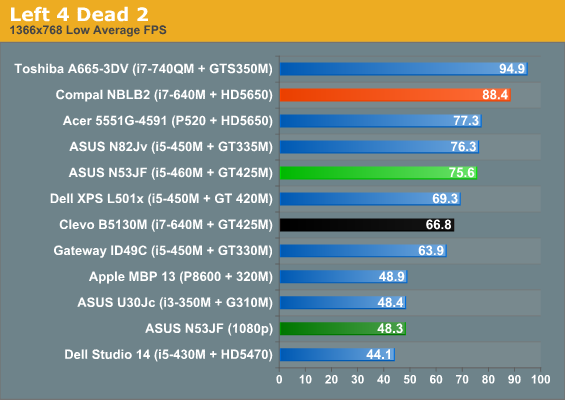
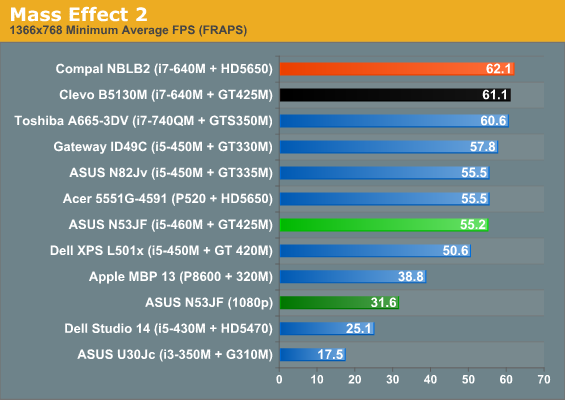
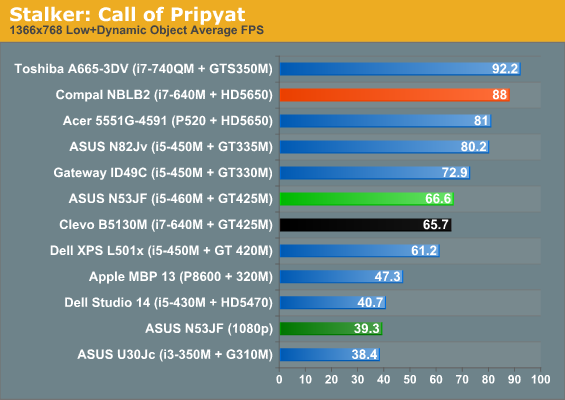

Starting at Low detail, about the only thing worth noting (other than the games all being playable) is that several titles benefit from the faster CPU in the Clevo notebook, but BFBC2, L4D2, and STALKER all give the ASUS a slight lead, with a larger 13% lead in L4D2. The Clevo notebook clocked the GPU the same, but used 1400MHz memory instead of 1600MHz RAM for graphics, so that 14% deficit shows up in some games more than others. Again, we ran Mafia 2 and Metro 2033 but are skipping the graphs for the time being. Mafia 2 manages 35FPS at 768p and 21.5FPS at 1080p, so it manages low detail and low resolution at least. Metro 2033 doesn’t even clear the 30FPS hurdle at 768p, scoring 26FPS and dropping into the teens (17FPS) at 1080p. The scores are basically right where we’d expect given the GPU and CPU.



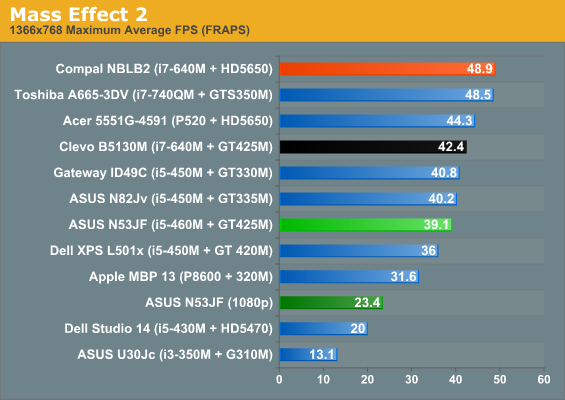
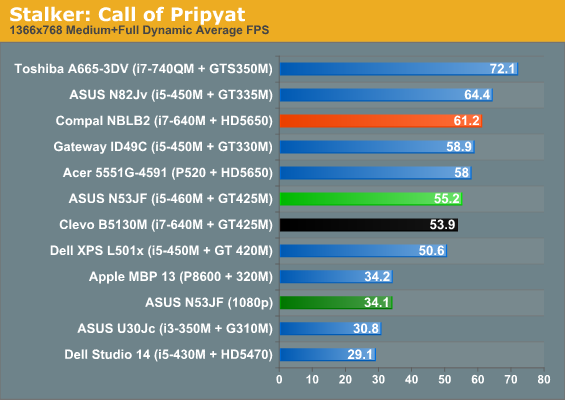

The story is similar at medium detail, and again the ASUS notebook leads the Clevo, this time in four out of six games. The lower memory bandwidth is definitely a factor here, though the difference isn’t so large as to be alarming and the faster CPU still pushes Clevo ahead in Mass Effect 2 and StarCraft II. 1080p with medium is only playable in STALKER and SC2, while the other titles will need to drop to a lower resolution. Mafia II and Metro 2033 continue their slide into unplayable territory, with scores of 30.4/18.1 and 24.4/16.1 respectively (at 768p/1080p). As mentioned in the Compal review, AMD’s HD 5650 also manages to lead the 420M/425M at our Medium settings in virtually every case, despite being six months older hardware.
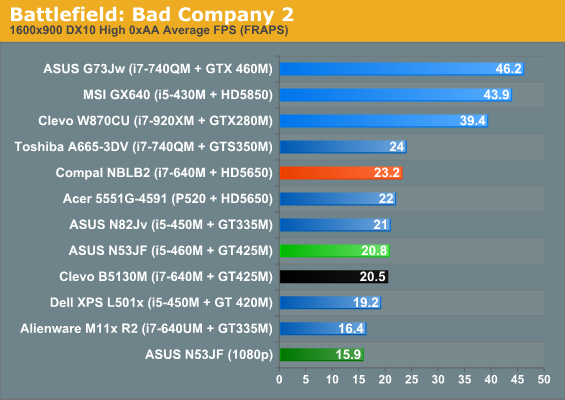
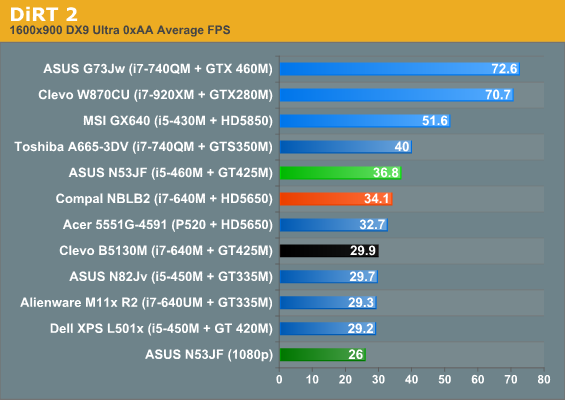
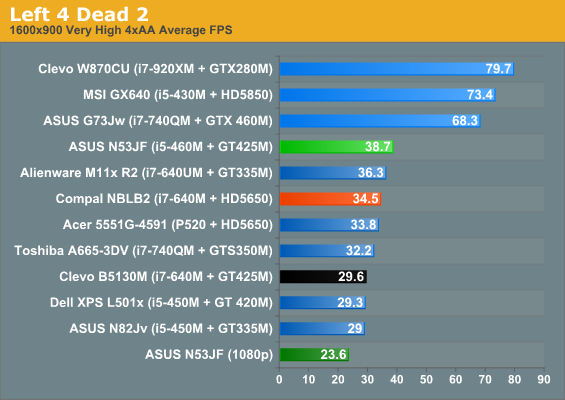
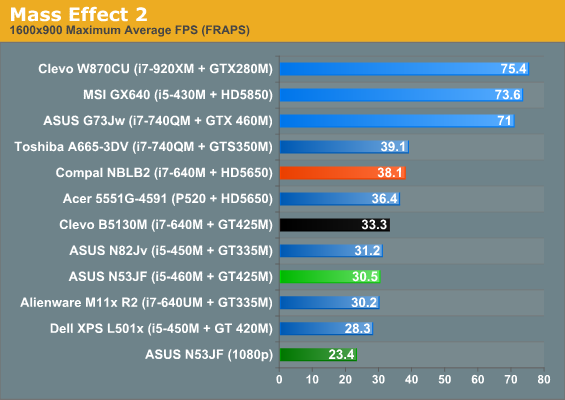
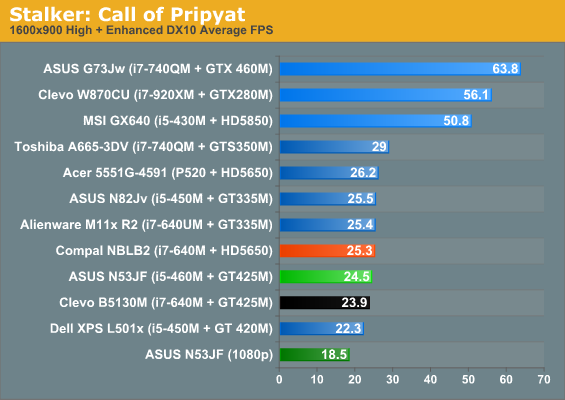

Finally, our High settings push many of the titles below 30FPS, though DiRT 2, L4D2, and ME2 all manage 900p High at >30FPS. As for Mafia II and Metro, they’re now down to 23.6/17.6 and 14.6/11.3 for 900p/1080p, which definitely isn’t playable. Also worth noting is that we continue to test games in DX9 or DX10 modes rather than DX11, as performance drops in nearly every DX11-enabled title and mobile GPUs aren’t usually fast enough to have the luxury of increasing detail levels. DiRT 2 is the odd man out, boasting higher performance at Ultra Low through Medium detail when DX11 is enabled, but the tables turn at the Ultra High setting. What we really need to make DX11 and high quality settings viable for notebooks is about twice the current level of performance—roughly equal to the HD 5850 or GTX 460M. “Midrange” laptops still require you to drop to lower resolutions, lower details settings, or both.










65 Comments
View All Comments
DanNeely - Wednesday, December 29, 2010 - link
I wouldn't hold my breath. The theater's originally went widescreen (1.85 in the US, 1.6 in the EU) to differentiate themselves from the 1.33 aspect ratio of TV and offer something more than a giant screen to compensate tor the extremely expensive food and obnoxious idiots you had to share the theater with.1.85 isn't much more than 1.77 and with 3D poised to invade the living room as well it won't serve well as a differentiator. Unless the studios decide to throw the theaters under a bus I expect something wider to go mainstream even if they stop short of 2.39.
DanNeely - Tuesday, January 4, 2011 - link
The end has begun, Vizio just launched a pair of 2.33:1 TVs at 2560x1080. I hope everyone is looking forward to their 2013 laptop running at 1400x600. It won't be deep enough to have a touchpad, so your lousy low contrast ultra-superglare LCD will be covered in fingrerprints from the touchscreen layer.http://ces.cnet.com/8301-32254_1-20027127-283.html
therealnickdanger - Tuesday, December 28, 2010 - link
The 1080 resolution was a standard HD resolution in the 80s and 90s, long before flat-screen, fixed-pixel displays were even being sold.While you may argue that 1080p is a step backward in resolution from the 1600x1200 CRTs of yesteryear - not even my beloved (and perfectly calibrated) Sony FW900 24" CRT can hold a candle to the clarity of my 1080p LCDs. Not to mention the LCDs are thinner, lighter, and much cheaper. Plus, having a true 1:1 pixel ratio for HD content is so much better. My wife is a professional video effects editor and can attest to the benefit of 1080p displays for her own reasons as well.
That's progress.
The only regress I can think of with modern displays is the loss of refresh rates over 60Hz. That's the only reason I keep the FW900 - for gaming w/VSYNC @85Hz and up. Analog FTW in that case. More and more 120Hz and 240Hz LCDs are coming out, but without proper mainstream connectivity, what's the point? Meh to that.
ET - Wednesday, December 29, 2010 - link
I agree that in some respects current displays are better than what we had ten years ago, but some things took a step back, and even if everything else was equal, it's not such significant progress. If I want a monitor that's better than 1920x1200 I need to pay a lot more than I did for the 1600x1200 19" monitor I bought 8 years ago, and it'd be a lot larger.One would have thought that by now it'd be possible to display high quality text and images on a PC monitor, but somehow we've degenerated into believing video is the only application that matters.
I agree that for standard users, who do just web and content surfing, current monitors are a step up from what they had in past years (1024x768, 1280x1024), but anyone more demanding could ten years ago get something that was a step up yet took about the same space and didn't cost 5 times more.
chemist1 - Tuesday, December 28, 2010 - link
Yup, what DanNeely said is right. Even with Blu-Ray, which represents the highest data rate currently available for consumer 1080p video (roughly twice what you get with terrestrial HD broadcasts, which in turn have higher data rates than cable, satellite, hulu, and netflix), the signal has to be compressed an amazing ~100:1 vs. a raw video feed! Only the cleverness of the compression algorithms, combined with the fact that large parts of a typical picture don't change much from frame to frame, allow this compression to still look good ---though it is still perceptually lossy on a high-end system (I understand Joe Kane did some studies to determine what data rate you would need to avoid all perceivable compression losses, but the results were for a private client and thus not published).Plus don' t forget that the current bandwidth limitations force compromises not just in spatial resolution, but also chromatic and temporal resolution. Blu-Ray movies today have 8-bit color (allowing for only 2^8=256 gradations). The standard does allow for higher color depth (up to 16 bit), but that means more data and, with the current bandwidth limit, that in turn would necessitate more compression. Likewise, at 60 fps we'd get more temporal resolution than we do at 24 or 30 fps, which would result in less blurring during fast action scenes. But if you go to 60 fps, you've got to give something else up.
I.e., with the current bandwidth limitations, we're at about the limit of how much spatial resolution the system can offer, unless we want to increase compression artifacts or give up further on the already-compromised chromatic or temporal resolution.
Don't get me wrong -- I have a 100" screen (JVC RS1 projector), and would love to see a consumer 4K format. But I'd also like to see at least a 12-bit 4:4:4 color space, and fewer compression artifacts---which is not going to happen until they can offer a bandwidth about an order of magnitude higher than what Blu-Ray currently offers.
And unfortunately, a lot of video seems to be moving in the same direction as music -- less resolution for more convenience. So I think it may be a while before we see market pressure for a higher-resolution video format.
DanNeely - Tuesday, December 28, 2010 - link
We also appear to be reaching the limits in what compression can offer. Over the summer I read that the team working on the H.265 algorithm were concerned that they'd only be able to reduce bitrates to 70% of current levels while maintaining quality levels vs the 50% target that they'd set when beginning the design process.torgal - Tuesday, December 28, 2010 - link
Well, and now Dell XPS 15 no longer have the 1080p upgrade (http://www.dell.com/us/p/xps-15/fs). Or have I got the wrong XPS 15?jigglywiggly - Tuesday, December 28, 2010 - link
hai guise my name is asus we make a good laptop and then ruin it by putting a POS LCD on it.Kaboose - Tuesday, December 28, 2010 - link
I think with sandy bridge on the horizon the majority of the people this laptop seems to be targeted at would be better off waiting a month or so for something more substantial for their ~$1000.jabber - Tuesday, December 28, 2010 - link
Surely it doesnt take 1 minute to wipe a product down before taking pics of it?Just makes it seem a little more pro.